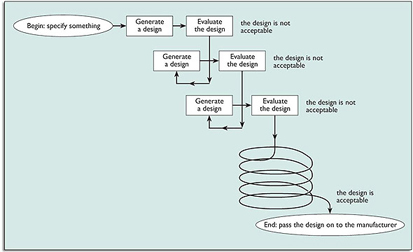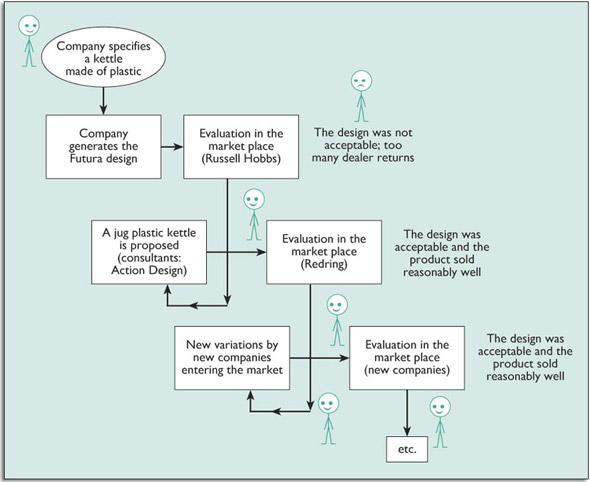3 Models of the design process
3.2 Building a simple model of design
In this section I am going to make a model of the design process. I'm not going to be specific about what is being designed; I want the discussion to be very general in a way that will apply to many products.
Design is a process with a beginning when the decision is made to design something; and an end when the design is complete, and the designed object is fabricated. So let our first model be Figure 14.
This model does not say much and is not very useful. After all, what is being designed? At the very least we need some kind of specification. So let Figure 15 be the next model.
But what does ‘Design it’ in Figure 15 mean? Originally there is nothing but the specification, and from this a design is generated. Is the design good or bad? In order to judge this, the design must be evaluated. So now the model becomes Figure 16.
Now, suppose the evaluation of the design suggests that it did not meet the specification very well, or that the object would not work as intended. What happens then? Usually it's ‘back to the drawing board’ – or possibly back to the specification in order to make changes to it. So we add an iterative loop into the model to get a design cycle, as shown in Figure 17.
If the design is judged to be unsatisfactory, there is a chance to have another go. The designer or the design team might even judge that the problem lay in the initial specification, and so could return and amend it before starting again or making changes.
For the purpose of this discussion, and for the moment, this model will be considered satisfactory.
SAQ 5
We have just ‘designed’ a model of the design process itself. Suppose the specification was ‘to produce a model of the design process’.
- How many generation stages were there?
- How many evaluation stages were there? What was the decision at each stage?
Answer
- Four models of the design process were generated, each adding something to the previous one.
- Each of these four models was evaluated. The first three were considered inadequate in various ways. The final model was evaluated as satisfactory.
I hope that as this model was constructed, you understood the steps involved in each development stage. If you were being critical, you may have anticipated the problems within each stage, and you should anyway have been making your own judgements as the model was developed. Perhaps you felt that the development should have been different, and perhaps you felt the final evaluation was rather complacent. Perhaps you thought that we should be able to produce a better model than that?
One of the important features of model-building is that, as with design itself, everyone can have a go, and the resulting models reflect personal tastes, knowledge and interests. Other models will be discussed in this section, and they are other people's attempts at representing the design process as they see it.
As you view these models you should be critical. Ask yourself what is good about them, and what is bad about them. In other words, evaluate them. Your criticisms should be constructive. Criticisms such as ‘This is rubbish’ do not take things far forward, either in developing a better model or in developing a better design. It's much more constructive to say: ‘This model fails in such and such a respect because of this or that reason, and this problem could be overcome by doing the following.’ In other words, constructive criticism involves identifying weakness (evaluation) and suggesting new ways of overcoming them (generation), and it is an essential part of design.
One misleading aspect of the diagrams that are used to model design is the suggestion that, when designers go round the generate–evaluate loop, they go back to where they started. Of course they don't, because by going round the loop they learn. Thus our simple design model could show the process unfolding in time, so that a spiral replaces the loop (Figure 18(a)).
Is this now a useful model of the design process? Let's consider this by applying it to our example from the previous section: the development of the plastic kettle.
The emergence of the plastic kettle owed more to Russell Hobbs taking advantage of new technological developments and spotting an opportunity for a new product rather than the company meeting real needs of users. However, there were evident needs, and these were to do with low costs, convenience and fashion. The starting point was the design of the Futura kettle by Russell Hobbs. Sales of this kettle were not high, possibly because it had no lid. In this case the market evaluation of the design was critical. The market didn't like it, and the company lost a lot of its confidence for producing such innovative designs.
However, plastic-kettle making did not stop, because someone else learned from the Futura experience, and came up with a different design. This design sold, possibly because it was novel, and possibly people believed it was more energy efficient because of the jug shape.
Other manufacturers observed the success of this product, and new plastic kettle designs evolved, to be evaluated by the market. For the evaluation of the kettle design, we have to add people (meaning the general public in the form of consumers) to the diagram. Our earlier spiral diagrams did not say who was doing what. Also, the spiral for the kettle development has no end. Design modifications will continue after the kettle is launched because of feedback from customers.
SAQ 6
Consider the development of the plastic kettle, as discussed above. Construct and label a spiral diagram giving a model of the development of the plastic kettle from the Futura onwards.
Answer
See Figure 18(b). It would be possible to make the diagram even more detailed. Inside each of the ‘generate’ boxes there is a generate–evaluate cycle by the designers and the commercial directors of the company, before they decide that the design is ready to go to market, where it will be tested by consumers.
Clearly the spiral diagram in Figure 18(b) gives only gives an approximation to what happened in the evolution of design of plastic kettle designs.






